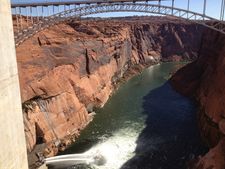Difference between revisions of "GCDAMP-Tamarisk Page"
From Glen Canyon Dam AMP
(add tamarisk page) |
(add tamarisk details) |
||
| Line 14: | Line 14: | ||
|birth_place = | |birth_place = | ||
}} | }} | ||
| − | *''' | + | *'''TAMARISK:''' |
| − | + | ||
| − | + | ||
| − | + | ||
| − | + | ||
| + | • Name: Tamarisk, saltceder/salt cedar, athel tree. | ||
| + | |||
| + | • From: Endemic to arid and semi-desert regions of Eurasia and Africa. | ||
| + | |||
| + | • Spread: Established in much of Europe and the continental U.S. One tamarisk can produce 250 million seeds per year that are spread easily by the wind. | ||
| + | |||
| + | • Problem: A mature tamarisk can transpire 200-300 gallons of water per day, and dense stands crowd out native vegetation. | ||
== 2014 == | == 2014 == | ||
Revision as of 09:16, 1 May 2014
Currently Under Construction
| Hydrograph Learning Page | |
 |
- TAMARISK:
• Name: Tamarisk, saltceder/salt cedar, athel tree.
• From: Endemic to arid and semi-desert regions of Eurasia and Africa.
• Spread: Established in much of Europe and the continental U.S. One tamarisk can produce 250 million seeds per year that are spread easily by the wind.
• Problem: A mature tamarisk can transpire 200-300 gallons of water per day, and dense stands crowd out native vegetation.
2014
2013
2012
2011
- AMWG- August 2010- Hydrograph 2011
- Proposed Water year 2011 Hydrograph: Impacts on CRSP Electric Power Resources [1]
- Grand Canyon Trust Hydrograph Proposal 2011 Attachment 7f
Contributor: Category: Water delivery